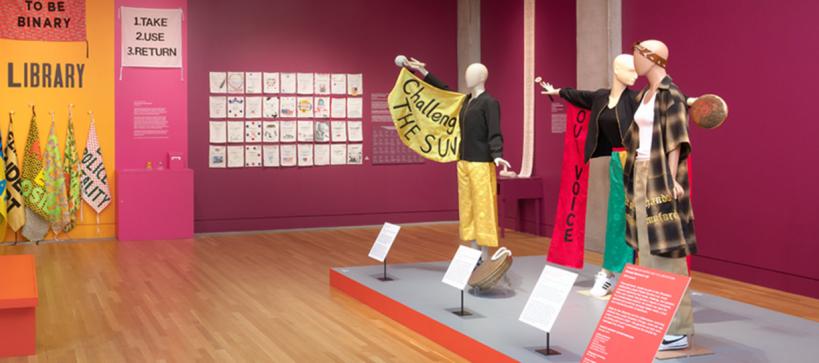
Detail of Talking Back to Power: Projects by Aram Han Sifuentes installation, photo by Robert Wedemeyer
Talking Back to Power: Projects by Aram Han Sifuentes
April 14–September 4, 2022

Detail of Talking Back to Power: Projects by Aram Han Sifuentes installation, photo by Robert Wedemeyer
April 14–September 4, 2022
This exhibition was on view at the Skirball
April 14–September 4, 2022
Exploring ideas of identity, power, and belonging in the United States, Talking Back to Power: Projects by Aram Han Sifuentes presents garments, banners, samplers, quilts, and sculptures that highlight American immigrant experiences.
The exhibition examines themes of justice and inclusion through artworks, including many that are co-created with the artist's community of collaborators. On view are pieces that delve into the artist’s own immigration experience, the valuable but undervalued labor that many immigrants provide, the official and unofficial ways that immigrants create spaces of belonging, and the power of creative protest for envisioning a better future.
“Talking Back to Power: Projects by Aram Han Sifuentes reminds us that artmaking has the power to bridge the personal and political, and envision social conditions where everybody can belong.”—Hyperallergic
Aram Han Sifuentes is a fiber and social practice artist, writer, and educator who works to center immigrant and disenfranchised communities. Her work often revolves around skill sharing, specifically sewing techniques, to create multiethnic and intergenerational sewing circles which become a place for empowerment, subversion, and protest.
Solo exhibitions of her work have been presented at the Jane Addams Hull-House Museum, Hyde Park Art Center, Chicago Cultural Center, Pulitzer Arts Foundation, and moCa Cleveland. Han Sifuentes is a 2016 Smithsonian Artist Research Fellow, 2016 3Arts Awardee, 2021 3Arts Next Level Awardee, 2020 Map Fund Grantee, and 2022 Center of Craft’s Craft Research Fund Artist Fellow.
Her project Protest Banner Lending Library, on view within Talking Back to Power, was a finalist for the Beazley Design Awards at the Design Museum (London, UK) in 2016. She earned her BA in Art and Latin American Studies from the University of California, Berkeley, and her MFA in Fiber and Material Studies from the School of the Art Institute of Chicago. She is currently an associate professor, adjunct, at the School of the Art Institute of Chicago.
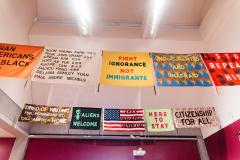
Protest Banner Lending Library explores the power of protest to generate ideas that help build a more just society. Aram Han Sifuentes and collaborators including community organizations, students, and workshop participants have created fabric banners—like this selection, hung from the ceiling of the Hurd Gallery—since 2016 bearing messages about topics ranging from racial justice to LGBT rights and beyond.
Selections from Protest Banner Lending Library, 2016–present. Photo by Morgan Foitle.
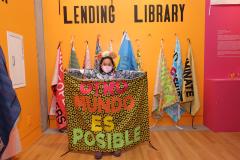
Aram Han Sifuentes created Protest Banner Lending Library as both a vehicle for creativity and a resource for activists championing diverse causes. The ongoing project’s workshops invite individuals who cannot always safely or easily participate in on-the-ground demonstrations—including undocumented immigrants, people with disabilities, and parents of young children—to create banners bearing their chosen slogans.
The library gives those who are more comfortable protesting in public the opportunity to check out the banners and bring them to protests. Skirball visitors can see, touch, build, and use the library—including by creating banners at monthly workshops and checking them out from the gallery—during the run of Talking Back to Power.
A young person holding a banner that reads “Otro Mundo Es Posible” (Spanish for “Another World is Possible”) from Protest Banner Lending Library, 2016–present. Photo by Steve Cohn.
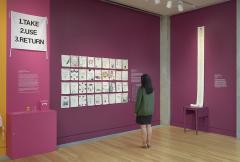
The ongoing US Citizenship Test Sampler Project is designed to help aspiring citizens study for the US Naturalization Test while commenting on the requirements for gaining citizenship. Aram Han Sifuentes teaches workshops to non-citizens in which she covers the test’s civics and history material alongside basic embroidery skills. The workshop participants then embroider the questions and answers to the test on fabric samplers—small pieces of cloth traditionally used to practice and demonstrate stitches, as well as to teach the alphabet and popular sayings, poems, or prayers.
Selections from US Citizenship Test Sampler Project, 2012–present. Photo by Robert Wedemeyer.
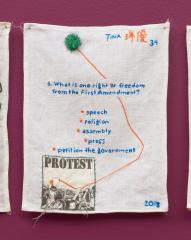
In the US Citizenship Test Sampler Project, Aram Han Sifuentes uses the format of the sampler to explore the ways in which immigrants are asked to prove their worth. The project comments on what she sees as a somewhat arbitrary measure of an immigrant’s suitability to become a citizen: passing a civics and history test that no US-born citizen is required to take.
Han Sifuentes offers the samplers for sale for the current cost of applying for citizenship; funds from the sales are paid in full to their creators.
Sampler created by US Citizenship Test Sampler Project workshop participant Tina. Photo by Robert Wedemeyer.
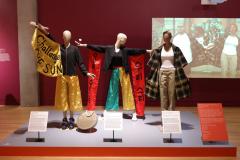
Aram Han Sifuentes and her collaborators Andrea Miros Ramírez, Eric Guy, and Miranda Betancourt play on the duality of clothing as an avenue for self-expression and a means of protecting oneself from the outside world in Protest Garment Lab.
They have designed garments to reveal slogans when opened, moved, or held in a certain position, drawing style cues from different communities of color. Talking Back to Power is the museum debut of these works, featuring both the garments on display and projected in site-specific performance videos.
Selections from Protest Garment Lab, 2021–present. Photo by Steve Cohn.
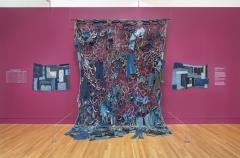
The daughter of South Korean immigrants who operated a dry-cleaning business after moving to the US, Aram Han Sifuentes began A Mend in 2011 out of a desire to learn the personal stories of others like her parents.
Han Sifuentes interviewed immigrant garment workers who do clothing alterations, asking what they did before they came to America, how long they’ve been in this country, and how much they charged to hem a pair of jeans—one of the most common alteration tasks. She collected remnant cuffs from the jeans they hemmed, stitching them together to form a net-like sculpture and a series of quilts that narrate the workers’ experiences through hand embroidery alongside data on their work in this country and their immigration histories.
Aram Han Sifuentes, A Mend, 2011–present. Photo by Robert Wedemeyer.
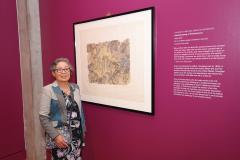
Underdrawing of Persimmons is a collaboration between Aram Han Sifuentes and her mother, Younghye Han (pictured), a classically trained artist who became a seamstress after immigrating to the US with her family.
The demands of working in the dry-cleaning business and raising two young children left Han little time to make art, but one of the few pieces she started was an underdrawing—a preliminary drawing for a traditional Korean ink painting. In 2015, when Han Sifuentes asked her mother when she intended to complete her painting, Han replied that her daughter should do it for her. Han Sifuentes dipped the work in wax, sealing the paper to preserve it in its unfinished state as a testimony to her mother’s history as an artist.
Younghye Han and Aram Han Sifuentes, Underdrawing of Persimmons, 1992–2015. Photo by Steve Cohn.
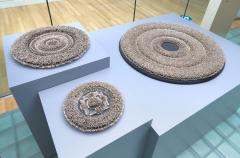
Temporarily on display in the Skirball’s permanent exhibition, Visions and Values: Jewish Life From Antiquity to America, Safety Pins is a trio of sculptures composed of found materials from Aram Han Sifuentes’s parents’ dry-cleaning store in Manteca, California.
Through hours of slowly stitching safety pins onto canvases in the form of a mandala—a sacred shape rooted in her Buddhist culture—Han Sifuentes commemorates the labor done by her parents and millions of other immigrant workers. The inclusion of these sculptures in the Liberty Gallery ties together the lived experiences of Jewish immigrants, who made up a large share of garment workers in the early twentieth century, to the Latin American and Asian immigrants who do this work today.
Aram Han Sifuentes, Safety Pins, 2010–2022. Photo by Robert Wedemeyer.
The Labor of US Citizenship, One Stitch at a Time
Hyperallergic | July 18, 2022
The Radical Power of Sewing: The Artist Turning Textiles into Activism
The Guardian | April 29, 2022
The exhibition and its related educational programs at the Skirball Cultural Center are made possible by generous support from the following donors:
Billie and Steve Fischer
Alicia Miñana and Rob Lovelace

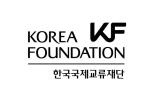
Additional support is provided by the following donor:
Soraya and Younes Nazarian Family Foundation